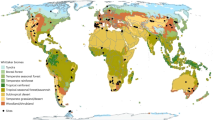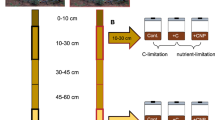Abstract
Microbial breakdown of soil organic matter influences the potential for terrestrial ecosystems to sequester carbon, and the amount of carbon dioxide released to the atmosphere1,2,3,4. Predicting the sensitivity of microbial decomposition to temperature change is therefore critical to predicting future atmospheric carbon dioxide concentrations and feedbacks to anthropogenic warming5. According to enzyme kinetics, the more biogeochemically recalcitrant the organic matter, the greater the temperature sensitivity of microbial respiration6,7,8. Here, we measured the temperature sensitivity of microbial respiration in soils from 28 sites in North America, ranging from Alaska to Puerto Rico, to test the generality of this principle. We show that the lower the rate of respiration at a reference temperature of 20 °C—and thus the more biogeochemically recalcitrant the organic matter—the greater the temperature sensitivity of soil respiration. We compiled our findings with those from other studies, encapsulating a range of environments, and show that this relationship holds across multiple scales and soil types. Although physico-chemical protection of soil organic matter and substrate availability will also influence the temperature sensitivity of decomposition, we suggest that biogeochemically recalcitrant organic matter will respond the most sensitively to anticipated warming.
This is a preview of subscription content, access via your institution
Access options
Subscribe to this journal
Receive 12 print issues and online access
$259.00 per year
only $21.58 per issue
Buy this article
- Purchase on Springer Link
- Instant access to full article PDF
Prices may be subject to local taxes which are calculated during checkout



Similar content being viewed by others
References
Denman, K. L. et al. in IPCC Climate Change 2007: The Physical Science Basis. Contribution of Working Group I to the Fourth Assessment Report of the Intergovernmental Panel on Climate Change (ed. Solomon, S.) (Cambridge Univ. Press, 2007).
Schuur, E. A. G. et al. The effect of permafrost thaw on old carbon release and net carbon exchange from tundra. Nature 459, 556–559 (2009).
Trumbore, S. E. & Czimczik, C. I. Geology—An uncertain future for soil carbon. Science 321, 1455–1456 (2008).
Friedlingstein, P. et al. Climate-carbon cycle feedback analysis: Results from the (CMIP)-M-4 model intercomparison. J. Clim. 19, 3337–3353 (2006).
Kirschbaum, M. U. F. The temperature dependence of soil organic matter decomposition, and the effect of global warming on soil organic C storage. Soil Biol. Biochem. 27, 753–760 (1995).
Davidson, E. A. & Janssens, I. A. Temperature sensitivity of soil carbon decomposition and feedbacks to climate change. Nature 440, 165–173 (2006).
Bosatta, E. & Ågren, G. I. Soil organic matter quality interpreted thermodynamically. Soil Biol. Biochem. 31, 1889–1891 (1999).
Fierer, N., Craine, J., McLauchlan, K. & Schimel, J. Litter quality and the temperature sensitivity of decomposition. Ecology 85, 320–326 (2005).
van der Meer, J. Metabolic theories in ecology. Trends Ecol. Evol. 21, 136–140 (2006).
von Lützow, M. & Kögel-Knabner, I. Temperature sensitivity of soil organic matter decomposition—what do we know? Biol. Fertil. Soils 46, 1–5 (2009).
Fang, C. M., Smith, P., Moncrieff, J. B. & Smith, J. U. Similar response of labile and resistant soil organic matter pools to changes in temperature. Nature 433, 57–59 (2005).
Knorr, W., Prentice, I. C., House, J. I. & Holland, E. A. Long-term sensitivity of soil carbon turnover to warming. Nature 433, 298–301 (2005).
Giardina, C. P. & Ryan, M. G. Evidence that decomposition rates of organic carbon in mineral soil do not vary with temperature. Nature 404, 858–861 (2000).
Conant, R. T. et al. Sensitivity of organic matter decomposition to warming varies with its quality. Glob. Change Biol. 14, 868–877 (2008).
Fierer, N., Colman, B. P., Schimel, J. P. & Jackson, R. B. Predicting the temperature dependence of microbial respiration in soil: A continental-scale analysis. Glob. Biogeochem. Cycles 20, GB3026 (2006).
Craine, J. M., Spurr, R., McLauchlan, K. K. & Fierer, N. Landscape-level variation in temperature sensitivity of soil organic carbon decomposition. Soil Biol. Biochem. 42, 373–375 (2010).
Conant, R. T. et al. Experimental warming shows that decomposition temperature sensitivity increases with soil organic matter recalcitrance. Ecology 89, 2384–2391 (2008).
Wright, I. J. et al. The worldwide leaf economics spectrum. Nature 428, 821–827 (2004).
Reich, P. B., Tjoelker, M. G., Machado, J. L. & Oleksyn, J. Universal scaling of respiratory metabolism, size and nitrogen in plants. Nature 439, 457–461 (2006).
Manzoni, S., Jackson, R. B., Trofymow, J. A. & Porporato, A. The global stoichiometry of litter nitrogen mineralization. Science 321, 684–686 (2008).
Parton, W. et al. Global-scale similarities in nitrogen release patterns during long-term decomposition. Science 315, 361–364 (2007).
West, G. B., Woodruff, W. H. & Brown, J. H. Allometric scaling of metabolic rate from molecules and mitochondria to cells and mammals. Proc. Natl Acad. Sci. USA 99, 2473–2478 (2002).
Fierer, N., Allen, A. S., Schimel, J. P. & Holden, P. A. Controls on microbial CO2 production: A comparison of surface and subsurface soil horizons. Glob. Change Biol. 9, 1322–1332 (2003).
McLauchlan, K. K. & Hobbie, S. E. Comparison of labile soil organic matter fractionation techniques. Soil Sci. Soc. Am. J. 68, 1616–1625 (2004).
Janos, P. Separation methods in the chemistry of humic substances. J. Chromatogr. A. 983, 1–18 (2003).
Thornley, J. H. M. & Cannell, M. G. R. Soil carbon storage response to temperature: An hypothesis. Ann. Bot. 87, 591–598 (2001).
von Oepen, B., Kordel, W. & Klein, W. Sorption of nonpolar and polar compounds to soils—processes, measurements and experience with the applicability of the modified OECD-guideline-106. Chemosphere 22, 285–304 (1991).
Gershenson, A., Bader, N. E. & Cheng, W. X. Effects of substrate availability on the temperature sensitivity of soil organic matter decomposition. Glob. Change Biol. 15, 176–183 (2009).
Robertson, G. P., Sollins, P., Ellis, B. G. & Lajtha, K. in Standard Soil Methods for Long-Term Ecological Research (eds Robertson, G. P., Coleman, D. C., Bledsoe, C. S. & Sollins, P.) 106–114 (Oxford Univ. Press, 1999).
Paul, E. A., Morris, S. J. & Bohm, S. in Assessment Methods for Soil Carbon (ed. Lal, R.) 193–206 (Lewis, 2001).
Acknowledgements
This research was sponsored by the National Science Foundation (DEB-0816629). We thank the many volunteers who provided soil for the experiment and R. Monson, P. Reich, M. Post and J. Schimel for providing helpful comments on the manuscript.
Author information
Authors and Affiliations
Contributions
All authors designed the experiment. J.M.C. and K.K.M. carried out the measurements. J.M.C. analysed the data and wrote the manuscript, to which all authors contributed discussion and text.
Corresponding author
Ethics declarations
Competing interests
The authors declare no competing financial interests.
Supplementary information
Supplementary Information
Supplementary Information (PDF 308 kb)
Rights and permissions
About this article
Cite this article
Craine, J., Fierer, N. & McLauchlan, K. Widespread coupling between the rate and temperature sensitivity of organic matter decay. Nature Geosci 3, 854–857 (2010). https://doi.org/10.1038/ngeo1009
Received:
Accepted:
Published:
Issue Date:
DOI: https://doi.org/10.1038/ngeo1009
This article is cited by
-
Projected soil carbon loss with warming in constrained Earth system models
Nature Communications (2024)
-
Drought may exacerbate dryland soil inorganic carbon loss under warming climate conditions
Nature Communications (2024)
-
Biophysical Controls on Soil Carbon Cycling in a Northern Hardwood Forest
Ecosystems (2024)
-
Quantifying thermal adaptation of soil microbial respiration
Nature Communications (2023)
-
A generic hierarchical model of organic matter degradation and preservation in aquatic systems
Communications Earth & Environment (2023)



